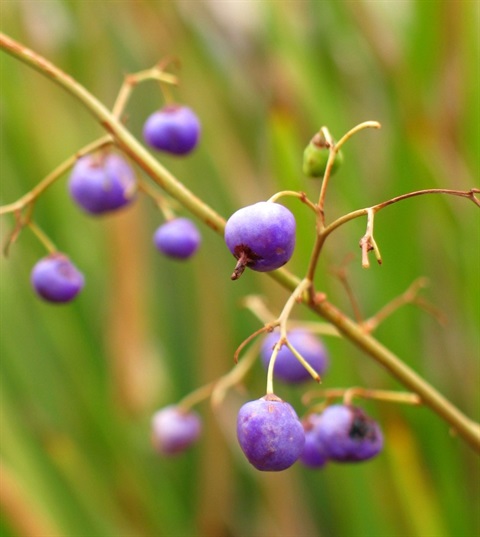
Dianella longifolia var. longifolia
Pale Flax-lily
Upright, narrowly tufted perennial, usually single clumps or with short underground stems. Clumps sometimes fan-shaped at base.
Additional information
- SynonymDianella laevis
- FamilyAsphodelaceae (syn. Hemerocallidaceae, Liliaceae, Phormiaceae)
- StoreyLower storey
- Size0.3-0.8 m x 0.5 m
- Plant groupingLilies & Irises
- LeavesSpreading bright green strap leaves 20-80 cm x 4-12 mm, V-shaped or Y-shaped in cross section, usually smooth on edges and midrib, not sheathed at base. Bases often purplish.
- Flower colourPale blue. Pale yellow anthers, orange swelling on stalk
- Flowering timeAugust to January
- FlowersOpen flowerheads, petals spreading to slightly turned back, flower stem higher than leaves. Berries shiny pale to mid blue. Flowers open in afternoon.
- Bird attractingBerries
- Butterfly attractingNo
- Frog habitatNo
- Growing conditionsMoist well drained soil in drier forests and woodlands. Frost tolerant. Full sun semi shade.
- Garden useAttractive clumping plant for rockeries, cottage gardens and underplanting of established trees.
- Commercially availableGenerally. Plants in general nurseries seldom local forms.
- Conservation statusWidespread within the Shire
- Aboriginal Use Food - berries, when ripe, seeds chewed; leaves - basket making, plaiting into cords; roots - medicine
- Related speciesDianella sp. aff. laevis (Montrose). Dianella sp. aff. laevis (Benambra) (syn D. longifolia var. grandis) has broader leaves, to 25 mm wide with reddish sheaths. Flowers are greenish-white to pale blue. Occurs by the Don R. near Launching Place.
Photo Gallery
Photographer/s: 1, 4, 5 Marilyn Bull ©; 2 Cathy Powers ©; 3 Colleen Miller ©
Plant Communities